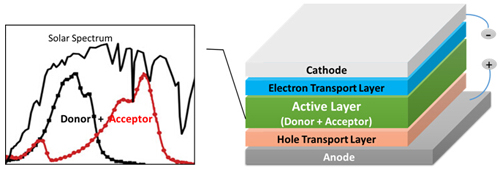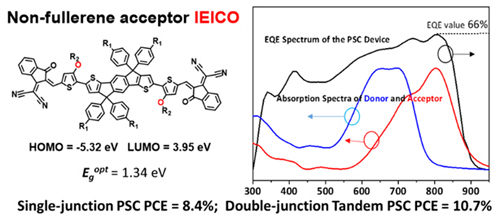Design and Application of a Low Bandgap Non-fullerene Small Molecule Acceptor in Polymer Solar Cells
Polymer solar cells (PSCs) with bulk heterojunction (BHJ) structure have received considerable attention from both the academic and industrial communities for its application in harnessing low-cost solar energy. The power conversion efficiencies (PCEs of PSCs) have been boosted to over 11% in recent years, demonstrating its great potential for practical applications. In order to make the most of the solar photons, design of low bandgap (LBG) material of which the absorption spectrum matches with solar spectrum is of great importance.

Typical BHJ PSCs structure and absorption spectra of the donor and acceptor (Image by Prof. HOU Jianhui)
In early studies, fullerene derivatives like PC61BM and PC71BM acted as acceptors in the PSCs, and many LBG polymer donors were developed and applied to utilize the solar photons in the long wavelength. Even though some of the fullerene-based PSCs fabricated by LBG polymer donors achieved good photovoltaic performance, these devices usually had large energy loss (> 0.6 eV) and relatively low external quantum efficiency (EQE) (< 60%). In the past two years, the non-fullerene acceptors have experienced rapid development, and the PCEs of fullerene-free PSCs have caught up with those of fullerene-based PSCs. The development of non-fullerene acceptor provides a new opportunity to constitute the active layer with broad absorption spectrum by using LBG acceptor, which may also address the problems of large energy loss and low EQE of the fullerene-based PSCs.

Chemical structure of the small molecule acceptor IEICO and corresponding absorption and EQE spectra (Image by Prof. HOU Jianhui)
A research group led by Prof. HOU Jianhui at the Institute of Chemistry, the Chinese Academy of Sciences (ICCAS), designed a novel LBG small acceptor and achieved an important progress in the fullerene-free PSCs. Their research results were published in Adv. Mater. entitled “Design and Synthesis of a Low Bandgap Small Molecule Acceptor for Efficient Polymer Solar Cells”.
In this study, they introduced strong electron-donating alkoxy group into a reported small molecule and synthesized a novel non-fullerene acceptor IEICO, which showed a narrowed optical bandgap of 1.34 eV by primarily lifting the energy of the highest occupied molecular orbital (HOMO) level. By adopting a polymer named PBDTTT-E-T as the donor material, the IEICO-based fullerene-free PSC device showed a maximum PCE of 8.4% with a high open-circuit voltage (VOC) of 0.82 V. An impressive EQE value of 66% was recorded at 810 nm. Furthermore, a high PCE of 10.7% was obtained in a tandem PSC device by using PBDTTT-E-T:IEICO as the rear cell.
This work was supported by the National Natural Science Foundation of China and the Chinese Academy of Sciences.
Contact:
Prof. HOU Jianhui
State Key Laboratory of Polymer Physics and Chemistry, Institute of Chemistry, the Chinese Academy of Science
Email: hjhzlz@iccas.ac.cn





